Vaping? Beware: Hard facts on a life-threatening habit
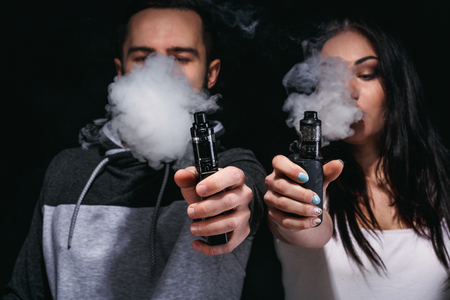
INQUIRER.net stock photo
College friends Manuel* and Joshua*, both students of a Catholic university in Manila, started smoking cigarettes when they were just minors. For once-teenagers like themselves, trying cigarettes could be chucked down to curiosity in the unfamiliar or peer pressure, but they were hooked on it for the stress relief. Soon after, they were smoking cigarettes by the pack.
“A day [usually] 5-6 [sticks]. May times na 3 packs a week or 60 sticks a week,” said Manuel. “We do it [because we’re] stressed and stress reliever siya. It makes me feel, ‘[alright], one less distraction.’”
Manuel and Joshua, both 21 years old, have now switched to “vaping” or using e-cigarettes or vapes, the most common of electronic nicotine delivery systems (ENDS), in an attempt to gradually lessen their nicotine intake and eventually break out of the cycle of addiction.

INQUIRER.net stock photo
Smokescreen of fruit flavors
Vaping is thought to be safer than cigarettes since it produces aerosol, referred to as vapor, and not tobacco smoke, which produces tar and contains carbon monoxide and other carcinogenic compounds. Meanwhile, the components of e-liquid or vape juice consist of propylene glycol and glycerol, which are often found in food products, as well as nicotine and flavoring agents.
Joshua thinks vaping perhaps may have potential dangers, but he claimed it is still better than the effects of smoking. Vapes, he said, were “designed to rehab smokers into quitting.”
“Style niya muna is mimic nicotine hanggang sa pababa ka ng pababa ng dosage ng nicotine hanggang sa hindi ka na talaga nag v-vape,” said Joshua. “Di naman talaga pang pass time ang vape dapat. Dapat tutulungan ka mag quit mag smoking and kung kayanin, is quit vaping na rin talaga.”
(Its style is it mimics nicotine at first until you eventually lower your dosage of nicotine, until you do not vape anymore. Vaping should not actually be a pastime. It should help you quit smoking, and if you already can, quit vaping too, eventually.)
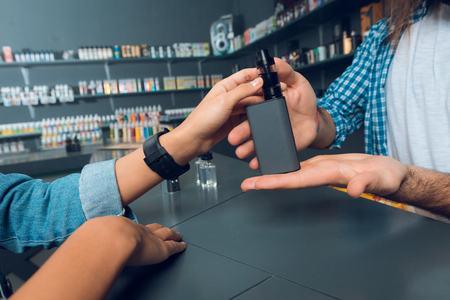
INQUIRER.net stock photo
This seems to be the overarching promise of vapes. This is, after all, the ethos in the promotion of ENDS. But to use ENDS as a last resort when quitting smoking has proved futile, as per the World Health Organization in a 2014 report. The WHO also noted that the promotion of ENDS conveys that one does not need to quit nicotine addiction, just smoking, and that one does not need to quit smoking because they can use ENDS in places where they cannot smoke.
Juul, the best-selling e-cigarette brand in the United States, banked on this same precept and peddled itself as “the alternative for adult smokers, designed for smokers, by smokers.” The company is currently in hot water and has been the object of scrutiny and investigations by the United States Congress, federal agencies and state attorneys general for its flavored vape pods which many have blamed had a hand in attracting the youth to get hooked on e-cigarettes. Following the backlash, Juul pulled its fruit and dessert flavors, such as mango and creme, from shelves on November 2018 and now only sells these fruit and dessert flavors on their website.
WHO’s 2014 report recommended regulatory options to countries that have not banned the sales of ENDS, one of which is to prohibit ENDS solutions with fruit and candy flavors until research shows that such flavors do not appeal to minors. The Centers for Disease Control and Prevention (CDC), for example, labels these flavors “kid-friendly.” A March 2019 study published on the Public Health Reports journal, on the other hand, showed that adolescents (12 to 17 years old) and young adults (18 to 24 years old) were more likely to use fruit-flavored e-cigarettes.
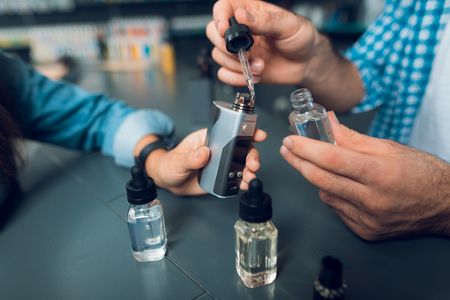
INQUIRER.net stock photo
The Department of Health pushed for the ban of e-cigarettes last Oct. 30, saying that it has no proven positive effect on the health of its users. Health Undersecretary Eric Domingo also claimed then that there are over one million Filipinos using e-cigarettes, majority of which are the youth.
President Rodrigo Duterte, before banning vapes in public, wanted to restrict the use of vapes by prohibiting fruity flavors, which attract smokers, as per finance secretary Carlos Dominguez III last Oct. 8.
“The President has already told me that when the regulation comes out, he wants to make sure that e-cigarettes taste only like tobacco and nothing else,” Dominguez told the press then.
A quick search on online retailers Lazada and Shopee, for example, would show sellers peddling vape pods and vape juice with different flavors, ranging from strawberry, watermelon, mango and cheesecake to lemonade and spearmint. There is even a Nerdz candy flavor and Coca-Cola. The same can be seen among vape juice being hawked on Facebook.
Duterte has since banned the use and importation of e-cigarettes on Nov. 19, saying he will order authorities to arrest anyone caught vaping in public. Senator Pia Cayetano, who heads the committee on ways and means, supported Duterte’s move on the same day, vowing to pursue higher tax on sin products and file a bill to regulate vapes.

INQUIRER.net stock photo
Duterte’s recent ban on the use of vapes in public, however, seems not to be a concern for Manuel and Joshua. Manuel expressed his skepticism, saying the ban would probably only be effective for the first couple of months.
Joshua, on the other hand, said the ban is only just right since vape groups also advocate that users should not vape in public. Vaping at home, however, is something else.
“Kanya-kanya na ‘yan. In private, maybe I’ll still continue,” he said. “If ever kailangan ko ng (I need) stress reliever.”
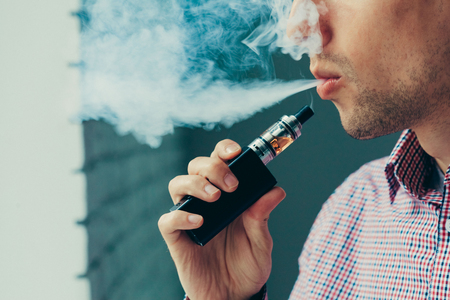
INQUIRER.net stock photo
Cases of vape-related injury
There has been an outbreak of vape-related injury in the U.S., with over 2,172 cases diagnosed with EVALI as of Nov. 13. Fifteen percent of the patients were identified as under 18 years old, while 38% were 18 to 24 years old. Meanwhile, 42 deaths thus far have been confirmed.
According to the CDC on Oct. 18, EVALI or E-cigarette or Vaping Product Use Associated Lung Injury is considered a diagnosis of exclusion because there are no specific tests for its diagnosis. The CDC and the Food and Drug Administration have not identified the cause(s) behind the lung injuries, although a breakthrough on Nov. 19 identified vitamin E acetate, used as an additive in THC-containing e-cigarettes, as a chemical of concern among those diagnosed with EVALI.
THC or tetrahydrocannabinol is a compound found in marijuana and has since found its way into e-liquids or vape juice. It was found that 83% of the 1,184 EVALI patients who had complete information used THC-containing products, with 35% reporting its exclusive use, three months before the onset of symptoms. Sixty-one percent, on the other hand, were found using nicotine-containing products, with 13% reporting its exclusive use. Marijuana is considered illegal in the Philippines, although it is uncertain to say if THC-laced vape juice is not being sold by black market sellers.
The Department of Health determined the first EVALI case in the Philippines just last Nov. 15. A 16-year-old girl from the Visayas region was diagnosed with EVALI after being admitted in a hospital on Oct. 21 for “sudden-onset severe shortness of breath.” The girl required oxygen supplementation, as per the report, and was admitted into the intensive care unit. She had apparently been vaping for 6 months while also smoking cigarettes at the same time, as per DOH.
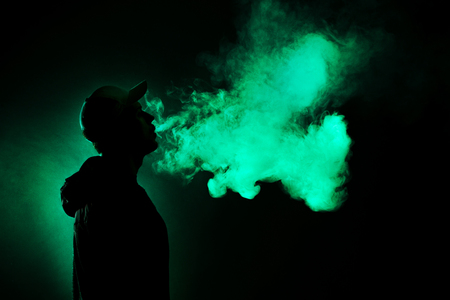
INQUIRER.net stock photo
Casualties as real cost of vaping
Corin Arenas, a health writer with an interest in longevity research, believes that now is a crucial time to inform Filipinos about the possible dangers of vaping. Arenas and her team at education organization Calculators.org have been keeping their eyes peeled on reports about vaping-related injury and deaths.
“When the casualties started rising [in the U.S.] and the CDC officially announced an outbreak of lung injuries linked to vaping, we knew we had to dig deeper and warn the public about the real risks of vaping,” said Arenas.
In a consolidated infographic report, Arenas showed that the way vapes are being marketed today is similar to how cigarettes were promoted in the 1940s to the early 1950s, when cigarette companies hired doctors to promote their advertisements. In fact, it was only in 1957 when U.S. Surgeon General Leroy Burney declared the U.S. Pubic Health Service’s official position that research evidence pointed to a causal relationship between smoking cigarettes and lung cancer, as per the U.S. National Library of Medicine.
There may be no evidence yet today that vape causes cancer, as per Arenas, but raising awareness now could help others before it is too late.
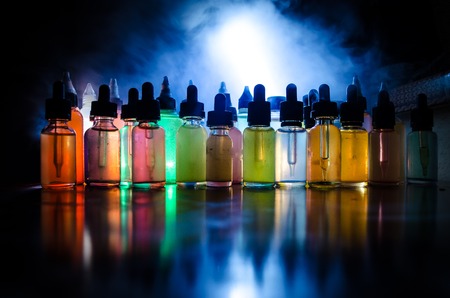
INQUIRER.net stock photo
Meanwhile, Dr. Maria Encarnita Limpin, a doctor and secretary of the Philippine College of Physicians, denounced last Oct. 17 the claims that vaping cannot cause cancer. Limpin said that e-cigarettes contain carcinogens that can develop the disease and may cause cancer after years of usage.
“But as like with the tobacco use, we have actually noted the development of cancer comes in after many years of usage,” she said. “So for them to say immediately that it does not cause cancer is too premature.”
The growing use of vapes among the youth may be due to the perception that it is less risky, Arenas also said.
“It’s being normalized in their environment. They are likely being targeted online by vaping ads, know friends who vape, and probably don’t get exposed as much to health news,” she explained. “If they see adults and people their age vaping, that sends a positive message. They will think e-cigarettes can’t be that bad.”
This, then, is why she believes it is important to communicate data to the public — and in a way that the data presented can engage the public and be understood properly.
“I feel whatever statistics or findings about its health risks should be highlighted not just in articles,” she said. “That’s why we created a comprehensive infographic that would likely engage people, especially the young about the dangers of vaping.”
The CDC offers an online guide for smokers who want to quit, which includes preparing oneself to quit by discerning one’s own reasons why, from learning how to handle withdrawal and building a support system.
Manuel, too, gave his two cents’ worth on those who could be thinking of trying cigarettes or vapes: just don’t do it.
“Just don’t smoke or vape from the start,” he said. “It’s hard to get out of the cycle of addiction.” JB
*(Editor’s note: Names of the students withheld upon request.)
RELATED STORIES:
Duterte warns judiciary not to mess with vaping, e-cigarettes ban